Customer Retention, ROI and Segmentation for Tesco PLC Report
VerifiedAdded on 2020/10/04
|9
|2708
|42
Report
AI Summary
This report analyzes customer retention strategies, lifetime value, and return on investment (ROI) within the context of Tesco PLC, a leading UK retailer. It examines Tesco's retention rates over several years, illustrating its ability to retain customers. The report delves into appropriate segmentation techniques, categorizing customers into new, old, and potential groups, and further segmenting the market demographically, professionally, and psychologically to tailor product offerings. The report also explores various effective retention strategies, including click-and-collect services, loyalty programs, mobile payment options, community building, SMS and email campaigns, and offering free products. Finally, it presents effective retention strategies such as setting customer expectations, becoming an expert in the field, building trust, and implementing anticipatory services. Various data analysis techniques like data preparation, cluster analysis, CHAID and CART analysis, and artificial neural networks are also discussed for calculating customer lifetime values.
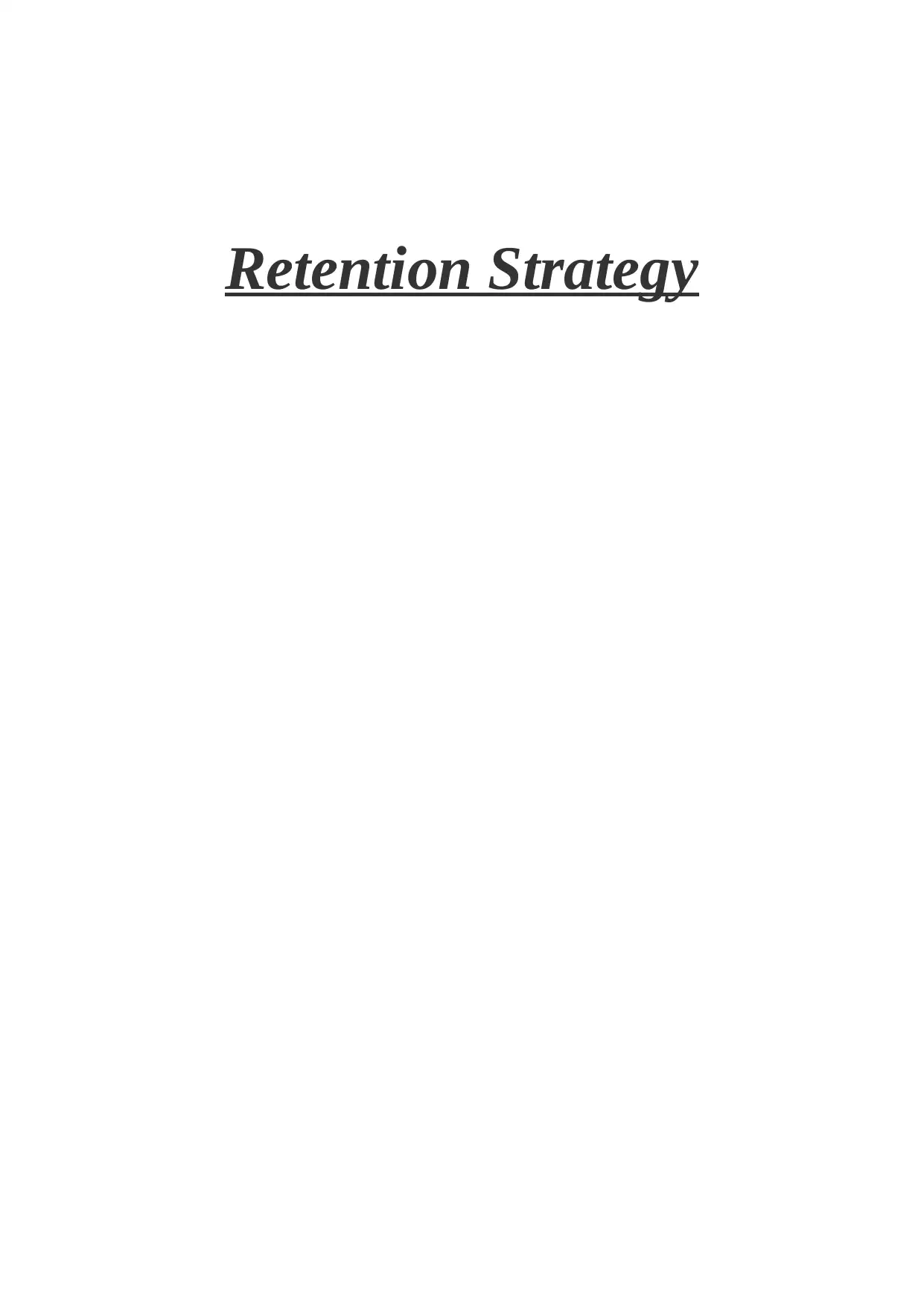
Retention Strategy
Paraphrase This Document
Need a fresh take? Get an instant paraphrase of this document with our AI Paraphraser

Table of Contents
Introduction...........................................................................................................................................3
Q.1 Retention rate, Life time value, return on investment....................................................................3
Q.2 Appropriate segmentation techniques ...........................................................................................4
Q.3 Effective retention strategies .........................................................................................................6
Conclusion ............................................................................................................................................8
References ............................................................................................................................................9
Introduction...........................................................................................................................................3
Q.1 Retention rate, Life time value, return on investment....................................................................3
Q.2 Appropriate segmentation techniques ...........................................................................................4
Q.3 Effective retention strategies .........................................................................................................6
Conclusion ............................................................................................................................................8
References ............................................................................................................................................9

Introduction
It is essential for a business organization is to create brand awareness and tries to
make product popular in the market. the sales representative responsible to interact with
customer and make their product and services in fulfil its needs. The customer relationship
management is one of the most critical task which required to developing various strategies
and tactics and make an appropriate plan (Heller Baird and Parasnis, 2011). The present
report based on Tesco PLC which is one of the leading retail corporation and operate their
business in the United Kingdom. The main purpose of this report to understand the customer
retention ratio, life time value for customer and return on investment. These all data help to
examine and analysing the actual performance of the company and design new strategies for
the future. So that they can meet its long term goals and targets in an effective manner.
Q.1 Retention rate, Life time value, return on investment
Retention rate: This ratio is defined how effectively an organisation can sustain its customer
for long time. For this purpose, a company can use various methods such as identify desired
and profitable customer behaviour, create advocates so that products can be passionate in
front of various customer. By the use of customer retention ratio an organisation is identified
their core customer. It is identified in as in percentage. This rate is defined a company's
quality of retention of their customers.
There are following retention rate of the cited frim as given below:
Particulars 2017 2018 2019
Retention rate=((E-
N) S) *100
75% 80% 85%
Life time value: This is the one way to analyse marketing cost to calculate life time
value of the customers. It is the revenue which a customer will earn in his life time. It is also
used in market budget. It is the tools by which an organisation can understand needs and
behaviour of your customers. Goals and objectives of the organisation is depending upon the
life time value. It includes expectation of customer from the organisation. When a company is
calculating its life time value they have to considers various factors. Life time value is most
powerful way to understand what a customer is worth to you and how their value is changed.
It is essential for a business organization is to create brand awareness and tries to
make product popular in the market. the sales representative responsible to interact with
customer and make their product and services in fulfil its needs. The customer relationship
management is one of the most critical task which required to developing various strategies
and tactics and make an appropriate plan (Heller Baird and Parasnis, 2011). The present
report based on Tesco PLC which is one of the leading retail corporation and operate their
business in the United Kingdom. The main purpose of this report to understand the customer
retention ratio, life time value for customer and return on investment. These all data help to
examine and analysing the actual performance of the company and design new strategies for
the future. So that they can meet its long term goals and targets in an effective manner.
Q.1 Retention rate, Life time value, return on investment
Retention rate: This ratio is defined how effectively an organisation can sustain its customer
for long time. For this purpose, a company can use various methods such as identify desired
and profitable customer behaviour, create advocates so that products can be passionate in
front of various customer. By the use of customer retention ratio an organisation is identified
their core customer. It is identified in as in percentage. This rate is defined a company's
quality of retention of their customers.
There are following retention rate of the cited frim as given below:
Particulars 2017 2018 2019
Retention rate=((E-
N) S) *100
75% 80% 85%
Life time value: This is the one way to analyse marketing cost to calculate life time
value of the customers. It is the revenue which a customer will earn in his life time. It is also
used in market budget. It is the tools by which an organisation can understand needs and
behaviour of your customers. Goals and objectives of the organisation is depending upon the
life time value. It includes expectation of customer from the organisation. When a company is
calculating its life time value they have to considers various factors. Life time value is most
powerful way to understand what a customer is worth to you and how their value is changed.
⊘ This is a preview!⊘
Do you want full access?
Subscribe today to unlock all pages.

Trusted by 1+ million students worldwide
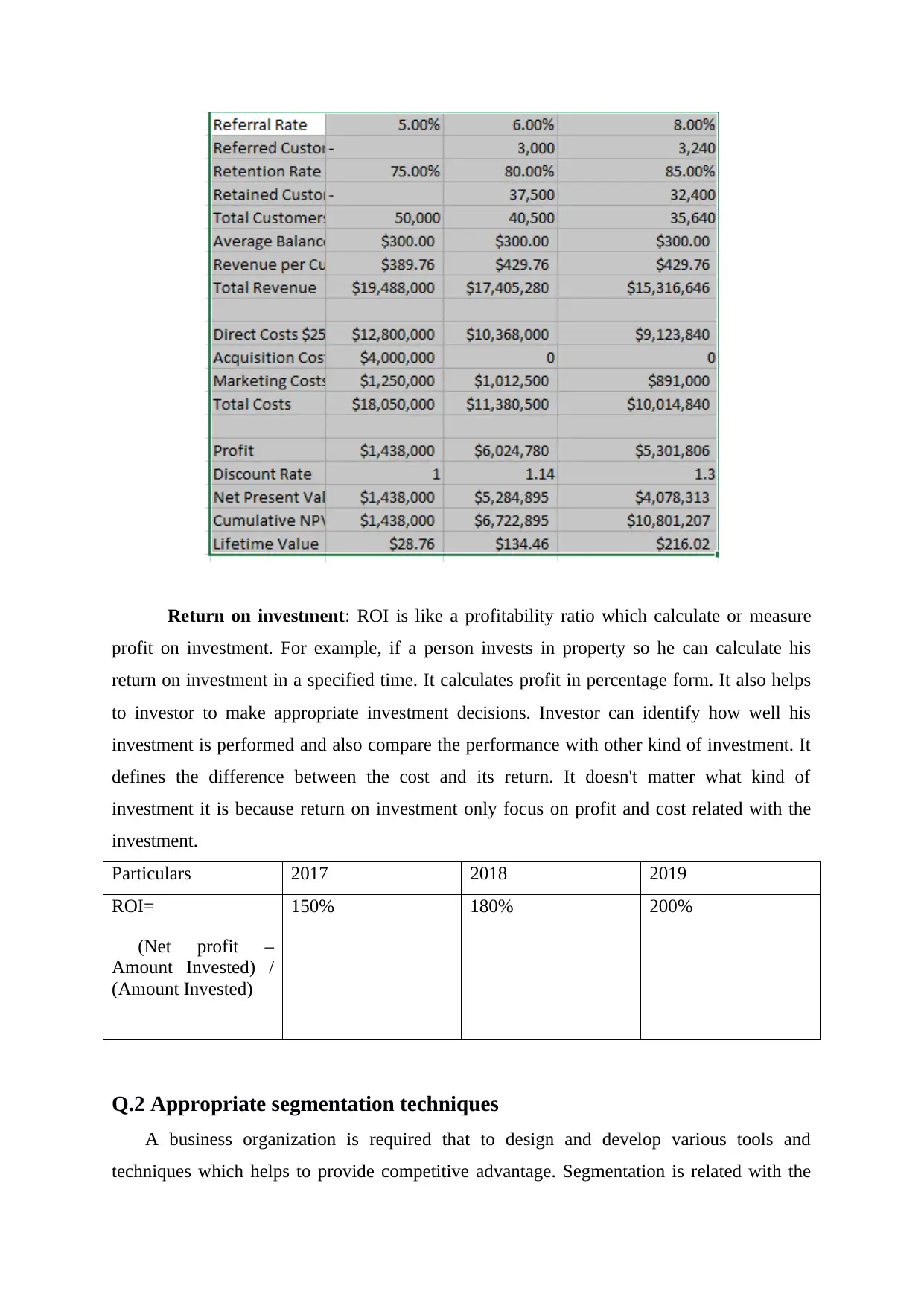
Return on investment: ROI is like a profitability ratio which calculate or measure
profit on investment. For example, if a person invests in property so he can calculate his
return on investment in a specified time. It calculates profit in percentage form. It also helps
to investor to make appropriate investment decisions. Investor can identify how well his
investment is performed and also compare the performance with other kind of investment. It
defines the difference between the cost and its return. It doesn't matter what kind of
investment it is because return on investment only focus on profit and cost related with the
investment.
Particulars 2017 2018 2019
ROI=
(Net profit –
Amount Invested) /
(Amount Invested)
150% 180% 200%
Q.2 Appropriate segmentation techniques
A business organization is required that to design and develop various tools and
techniques which helps to provide competitive advantage. Segmentation is related with the
profit on investment. For example, if a person invests in property so he can calculate his
return on investment in a specified time. It calculates profit in percentage form. It also helps
to investor to make appropriate investment decisions. Investor can identify how well his
investment is performed and also compare the performance with other kind of investment. It
defines the difference between the cost and its return. It doesn't matter what kind of
investment it is because return on investment only focus on profit and cost related with the
investment.
Particulars 2017 2018 2019
ROI=
(Net profit –
Amount Invested) /
(Amount Invested)
150% 180% 200%
Q.2 Appropriate segmentation techniques
A business organization is required that to design and develop various tools and
techniques which helps to provide competitive advantage. Segmentation is related with the
Paraphrase This Document
Need a fresh take? Get an instant paraphrase of this document with our AI Paraphraser

divination market in to small parts and offer products accordingly (Reimann, Schilke and
Thomas, 2010). This is the responsibility of sales department is to make an appropriate
customer relation program which increase customer loyalty and enhanced their profitability
which is a common goal for every business unit. apart from that they also required that to
maintain historical data which can be analyse and evaluate for the future performance. In the
context of Tesco, they can divide their customer in to three category one is related with new
customer, another one is old customer and thirds potential customers.
For old customer they try to make more focus because they can be loyal in the near future.
Apart from that, they can design and develop such strategies which benefit old customer and
increase competitive advantage in the market. on the other hand, the cited firm can also
divide the overall market in to different aspects such as demographic, professional and
psychological (Khodakarami and Chan, 2014). For example, Tesco can divide UK market in
to four category Britain, Wales, Scotland, and Ireland and offer products accordingly.
Because there having different culture, taste, preferences and so on. they also required to
conduct customer survey which helps to identify their needs and design its product and
services. It helps to increase customer satisfaction level and leads to enhanced profitability
which is a common goal for every business unit.
3 Retention strategies for independent retailers
An organisation can use lots of retention strategies for sustain its customers for long
time. There are some retention strategies which are mentioned below:
Click and collect: It includes click and collect the customers. A way to offering products to
clients such as products can browse online so many customers have clicked by the company.
For example it is used for the mobile shoppers who have no time to browse in store so they
can show their products online so clients are easily click on the products (Coltman, Devinney
and Midgley, 2011).
Loyalty reward programme: A organisation can sustain his customers for long time period
by giving them rewards, free coupons, bonus and discounts on various products. It includes
benefits of loyalty program that is help to customize different customers. If a company can
use this tool than it increases mobile friendly and offers are also convenient for customers. If
customers are highly mobile friendly than company can use SMS marketing system of
products.
Offering mobile payments and digital receipts: Now in modern days when people are
mobile friendly an organisation can provide them facility of mobile payments and digital
Thomas, 2010). This is the responsibility of sales department is to make an appropriate
customer relation program which increase customer loyalty and enhanced their profitability
which is a common goal for every business unit. apart from that they also required that to
maintain historical data which can be analyse and evaluate for the future performance. In the
context of Tesco, they can divide their customer in to three category one is related with new
customer, another one is old customer and thirds potential customers.
For old customer they try to make more focus because they can be loyal in the near future.
Apart from that, they can design and develop such strategies which benefit old customer and
increase competitive advantage in the market. on the other hand, the cited firm can also
divide the overall market in to different aspects such as demographic, professional and
psychological (Khodakarami and Chan, 2014). For example, Tesco can divide UK market in
to four category Britain, Wales, Scotland, and Ireland and offer products accordingly.
Because there having different culture, taste, preferences and so on. they also required to
conduct customer survey which helps to identify their needs and design its product and
services. It helps to increase customer satisfaction level and leads to enhanced profitability
which is a common goal for every business unit.
3 Retention strategies for independent retailers
An organisation can use lots of retention strategies for sustain its customers for long
time. There are some retention strategies which are mentioned below:
Click and collect: It includes click and collect the customers. A way to offering products to
clients such as products can browse online so many customers have clicked by the company.
For example it is used for the mobile shoppers who have no time to browse in store so they
can show their products online so clients are easily click on the products (Coltman, Devinney
and Midgley, 2011).
Loyalty reward programme: A organisation can sustain his customers for long time period
by giving them rewards, free coupons, bonus and discounts on various products. It includes
benefits of loyalty program that is help to customize different customers. If a company can
use this tool than it increases mobile friendly and offers are also convenient for customers. If
customers are highly mobile friendly than company can use SMS marketing system of
products.
Offering mobile payments and digital receipts: Now in modern days when people are
mobile friendly an organisation can provide them facility of mobile payments and digital
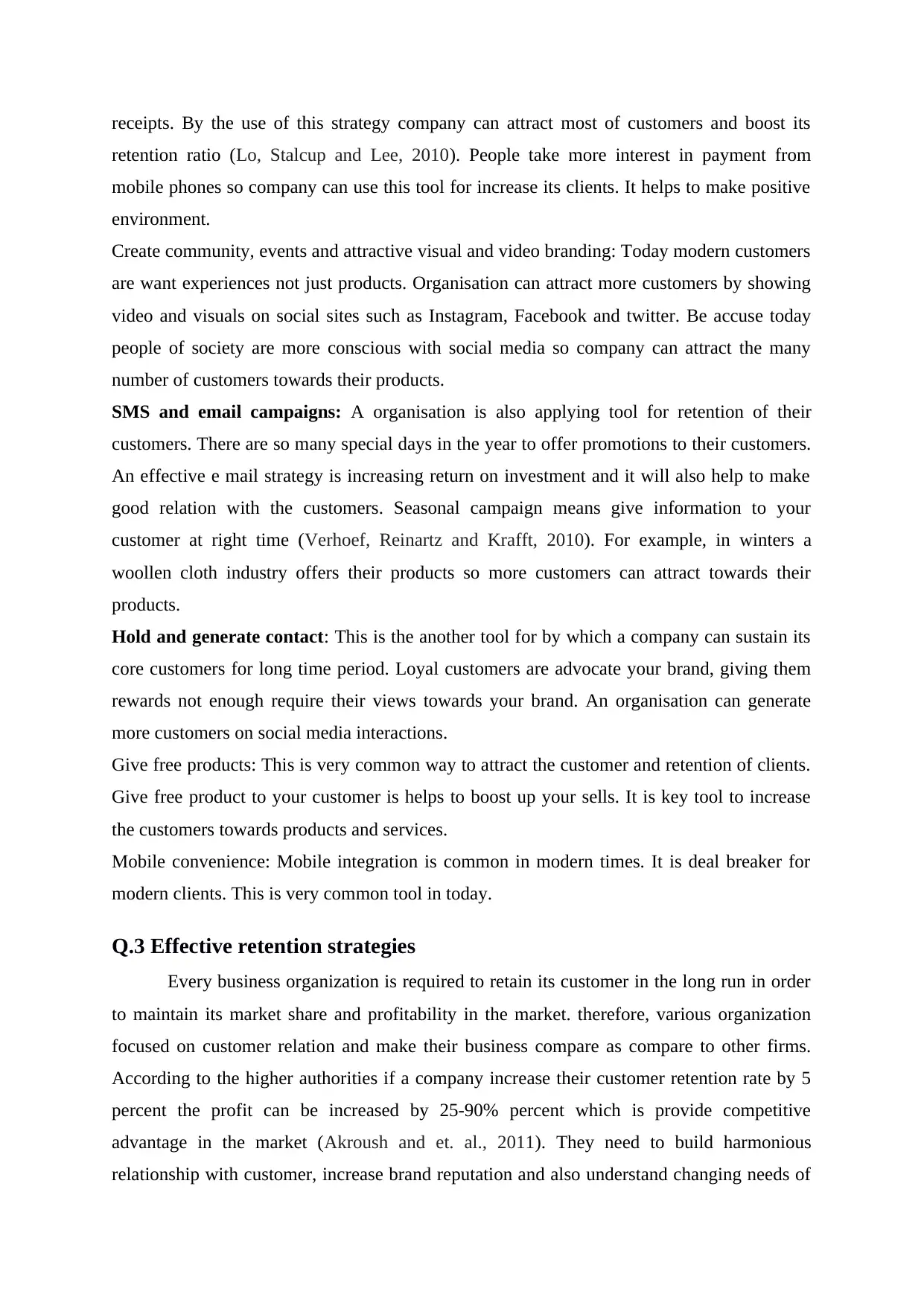
receipts. By the use of this strategy company can attract most of customers and boost its
retention ratio (Lo, Stalcup and Lee, 2010). People take more interest in payment from
mobile phones so company can use this tool for increase its clients. It helps to make positive
environment.
Create community, events and attractive visual and video branding: Today modern customers
are want experiences not just products. Organisation can attract more customers by showing
video and visuals on social sites such as Instagram, Facebook and twitter. Be accuse today
people of society are more conscious with social media so company can attract the many
number of customers towards their products.
SMS and email campaigns: A organisation is also applying tool for retention of their
customers. There are so many special days in the year to offer promotions to their customers.
An effective e mail strategy is increasing return on investment and it will also help to make
good relation with the customers. Seasonal campaign means give information to your
customer at right time (Verhoef, Reinartz and Krafft, 2010). For example, in winters a
woollen cloth industry offers their products so more customers can attract towards their
products.
Hold and generate contact: This is the another tool for by which a company can sustain its
core customers for long time period. Loyal customers are advocate your brand, giving them
rewards not enough require their views towards your brand. An organisation can generate
more customers on social media interactions.
Give free products: This is very common way to attract the customer and retention of clients.
Give free product to your customer is helps to boost up your sells. It is key tool to increase
the customers towards products and services.
Mobile convenience: Mobile integration is common in modern times. It is deal breaker for
modern clients. This is very common tool in today.
Q.3 Effective retention strategies
Every business organization is required to retain its customer in the long run in order
to maintain its market share and profitability in the market. therefore, various organization
focused on customer relation and make their business compare as compare to other firms.
According to the higher authorities if a company increase their customer retention rate by 5
percent the profit can be increased by 25-90% percent which is provide competitive
advantage in the market (Akroush and et. al., 2011). They need to build harmonious
relationship with customer, increase brand reputation and also understand changing needs of
retention ratio (Lo, Stalcup and Lee, 2010). People take more interest in payment from
mobile phones so company can use this tool for increase its clients. It helps to make positive
environment.
Create community, events and attractive visual and video branding: Today modern customers
are want experiences not just products. Organisation can attract more customers by showing
video and visuals on social sites such as Instagram, Facebook and twitter. Be accuse today
people of society are more conscious with social media so company can attract the many
number of customers towards their products.
SMS and email campaigns: A organisation is also applying tool for retention of their
customers. There are so many special days in the year to offer promotions to their customers.
An effective e mail strategy is increasing return on investment and it will also help to make
good relation with the customers. Seasonal campaign means give information to your
customer at right time (Verhoef, Reinartz and Krafft, 2010). For example, in winters a
woollen cloth industry offers their products so more customers can attract towards their
products.
Hold and generate contact: This is the another tool for by which a company can sustain its
core customers for long time period. Loyal customers are advocate your brand, giving them
rewards not enough require their views towards your brand. An organisation can generate
more customers on social media interactions.
Give free products: This is very common way to attract the customer and retention of clients.
Give free product to your customer is helps to boost up your sells. It is key tool to increase
the customers towards products and services.
Mobile convenience: Mobile integration is common in modern times. It is deal breaker for
modern clients. This is very common tool in today.
Q.3 Effective retention strategies
Every business organization is required to retain its customer in the long run in order
to maintain its market share and profitability in the market. therefore, various organization
focused on customer relation and make their business compare as compare to other firms.
According to the higher authorities if a company increase their customer retention rate by 5
percent the profit can be increased by 25-90% percent which is provide competitive
advantage in the market (Akroush and et. al., 2011). They need to build harmonious
relationship with customer, increase brand reputation and also understand changing needs of
⊘ This is a preview!⊘
Do you want full access?
Subscribe today to unlock all pages.

Trusted by 1+ million students worldwide
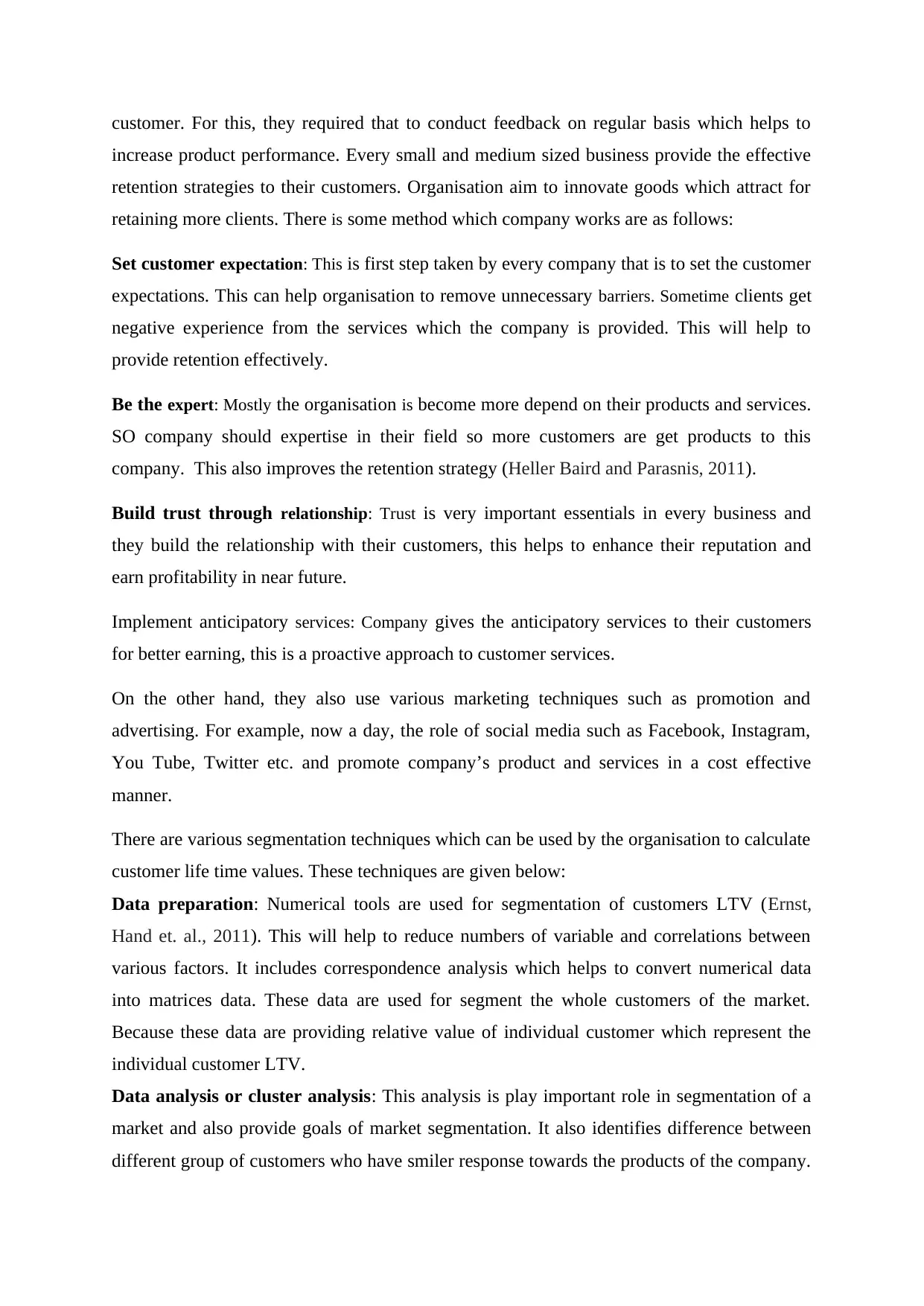
customer. For this, they required that to conduct feedback on regular basis which helps to
increase product performance. Every small and medium sized business provide the effective
retention strategies to their customers. Organisation aim to innovate goods which attract for
retaining more clients. There is some method which company works are as follows:
Set customer expectation: This is first step taken by every company that is to set the customer
expectations. This can help organisation to remove unnecessary barriers. Sometime clients get
negative experience from the services which the company is provided. This will help to
provide retention effectively.
Be the expert: Mostly the organisation is become more depend on their products and services.
SO company should expertise in their field so more customers are get products to this
company. This also improves the retention strategy (Heller Baird and Parasnis, 2011).
Build trust through relationship: Trust is very important essentials in every business and
they build the relationship with their customers, this helps to enhance their reputation and
earn profitability in near future.
Implement anticipatory services: Company gives the anticipatory services to their customers
for better earning, this is a proactive approach to customer services.
On the other hand, they also use various marketing techniques such as promotion and
advertising. For example, now a day, the role of social media such as Facebook, Instagram,
You Tube, Twitter etc. and promote company’s product and services in a cost effective
manner.
There are various segmentation techniques which can be used by the organisation to calculate
customer life time values. These techniques are given below:
Data preparation: Numerical tools are used for segmentation of customers LTV (Ernst,
Hand et. al., 2011). This will help to reduce numbers of variable and correlations between
various factors. It includes correspondence analysis which helps to convert numerical data
into matrices data. These data are used for segment the whole customers of the market.
Because these data are providing relative value of individual customer which represent the
individual customer LTV.
Data analysis or cluster analysis: This analysis is play important role in segmentation of a
market and also provide goals of market segmentation. It also identifies difference between
different group of customers who have smiler response towards the products of the company.
increase product performance. Every small and medium sized business provide the effective
retention strategies to their customers. Organisation aim to innovate goods which attract for
retaining more clients. There is some method which company works are as follows:
Set customer expectation: This is first step taken by every company that is to set the customer
expectations. This can help organisation to remove unnecessary barriers. Sometime clients get
negative experience from the services which the company is provided. This will help to
provide retention effectively.
Be the expert: Mostly the organisation is become more depend on their products and services.
SO company should expertise in their field so more customers are get products to this
company. This also improves the retention strategy (Heller Baird and Parasnis, 2011).
Build trust through relationship: Trust is very important essentials in every business and
they build the relationship with their customers, this helps to enhance their reputation and
earn profitability in near future.
Implement anticipatory services: Company gives the anticipatory services to their customers
for better earning, this is a proactive approach to customer services.
On the other hand, they also use various marketing techniques such as promotion and
advertising. For example, now a day, the role of social media such as Facebook, Instagram,
You Tube, Twitter etc. and promote company’s product and services in a cost effective
manner.
There are various segmentation techniques which can be used by the organisation to calculate
customer life time values. These techniques are given below:
Data preparation: Numerical tools are used for segmentation of customers LTV (Ernst,
Hand et. al., 2011). This will help to reduce numbers of variable and correlations between
various factors. It includes correspondence analysis which helps to convert numerical data
into matrices data. These data are used for segment the whole customers of the market.
Because these data are providing relative value of individual customer which represent the
individual customer LTV.
Data analysis or cluster analysis: This analysis is play important role in segmentation of a
market and also provide goals of market segmentation. It also identifies difference between
different group of customers who have smiler response towards the products of the company.
Paraphrase This Document
Need a fresh take? Get an instant paraphrase of this document with our AI Paraphraser

There are two type of cluster analysis hierarchical and iterative analysis and both can be used
for segmentation of market. But hierarchical analysis is difficult to use if you have more than
200 respondents. So iterative analysis can be used for market segmentation.
Data analysis- CHAID and CART: This is classification of tree method. This method
divided total customers in a group and after that divide in sub groups. There are some
depended and some are independent variables. This procedure creates tree diagram starting
from the top with two group and each level of the tree. CHAID is most commonly used
method for the segmentation of market and customers available in the society. On the other
hand, cluster analysis, segmentation of tree method creates best segment when they divide the
respondents (Reimann, Schilke, and Thomas, 2010).
Data analysis- Artificial neural network: This is another technique for segmentation. It is
self-organising because there is no dependable variable like cluster analysis which is
specified in the model. This method is focuses on the similarities of different groups towards
the products of the company. It is different from cluster analysis. It is identified that this
analysis is most appropriate rather than cluster analysis of data.
Classification algorithms: There is various classification of algorithms which is used for the
segmentation of the market. Discriminant analysis is most appropriate for classify
segmentation of groups. Segmentation is helps to identified respondents belong from which
in each market segment. If company use limited set of information than they have to
successfully classification of algorithms. So basically it includes selection of area of
segmentation.
Conclusion
As per the above mentioned report it has been concluded that the significance of
retention rate of customer in the future performance of the company. the report also
calculates various data such as customer retention rate which is to significant for the business
performance. Apart from that there are various strategies and tactics which helps to meet long
term targets in an effective manner. the report also explained about the customer life time
value which can be calculated by the use of various approaches which increase customer
satisfaction level.
for segmentation of market. But hierarchical analysis is difficult to use if you have more than
200 respondents. So iterative analysis can be used for market segmentation.
Data analysis- CHAID and CART: This is classification of tree method. This method
divided total customers in a group and after that divide in sub groups. There are some
depended and some are independent variables. This procedure creates tree diagram starting
from the top with two group and each level of the tree. CHAID is most commonly used
method for the segmentation of market and customers available in the society. On the other
hand, cluster analysis, segmentation of tree method creates best segment when they divide the
respondents (Reimann, Schilke, and Thomas, 2010).
Data analysis- Artificial neural network: This is another technique for segmentation. It is
self-organising because there is no dependable variable like cluster analysis which is
specified in the model. This method is focuses on the similarities of different groups towards
the products of the company. It is different from cluster analysis. It is identified that this
analysis is most appropriate rather than cluster analysis of data.
Classification algorithms: There is various classification of algorithms which is used for the
segmentation of the market. Discriminant analysis is most appropriate for classify
segmentation of groups. Segmentation is helps to identified respondents belong from which
in each market segment. If company use limited set of information than they have to
successfully classification of algorithms. So basically it includes selection of area of
segmentation.
Conclusion
As per the above mentioned report it has been concluded that the significance of
retention rate of customer in the future performance of the company. the report also
calculates various data such as customer retention rate which is to significant for the business
performance. Apart from that there are various strategies and tactics which helps to meet long
term targets in an effective manner. the report also explained about the customer life time
value which can be calculated by the use of various approaches which increase customer
satisfaction level.
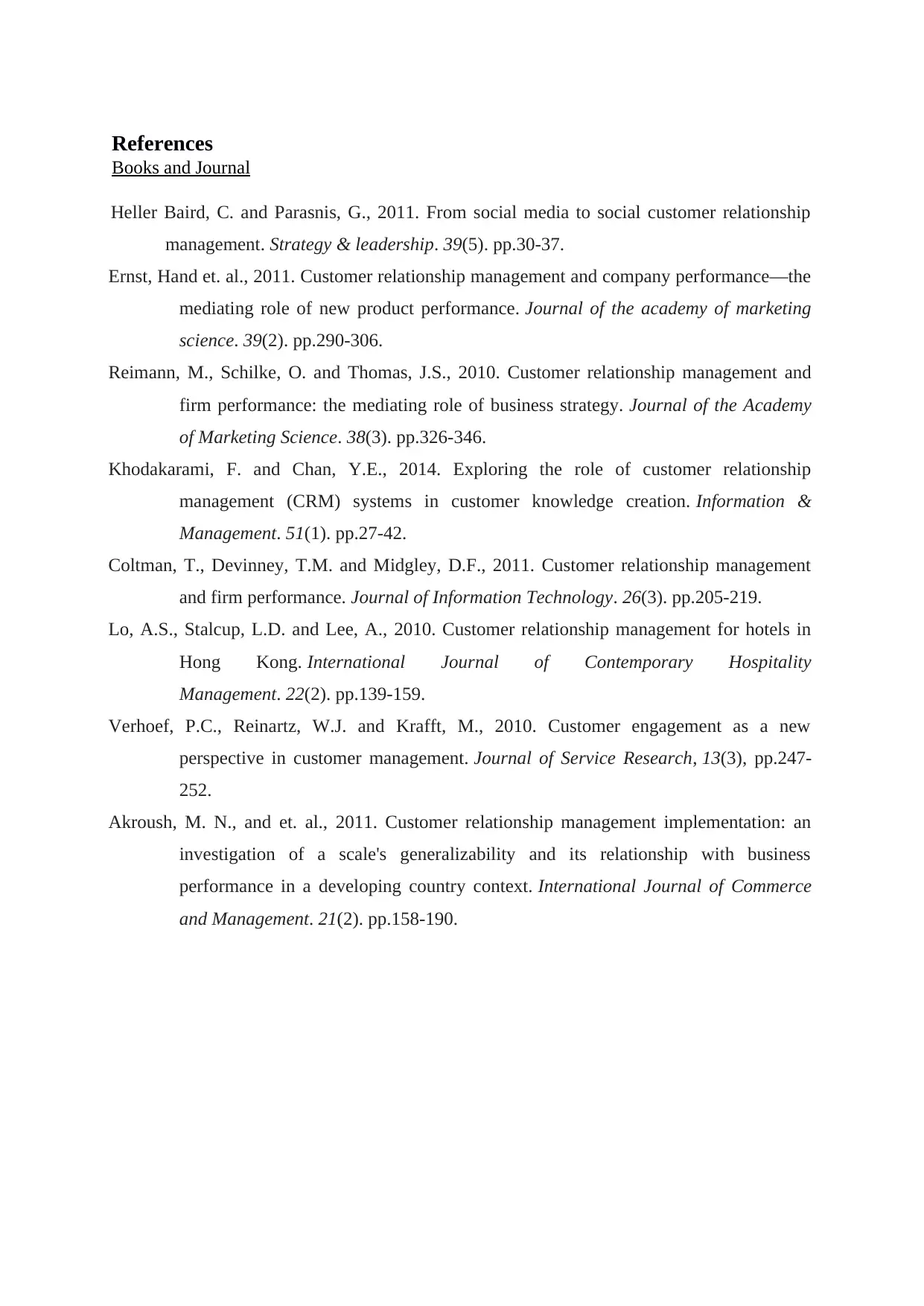
References
Books and Journal
Heller Baird, C. and Parasnis, G., 2011. From social media to social customer relationship
management. Strategy & leadership. 39(5). pp.30-37.
Ernst, Hand et. al., 2011. Customer relationship management and company performance—the
mediating role of new product performance. Journal of the academy of marketing
science. 39(2). pp.290-306.
Reimann, M., Schilke, O. and Thomas, J.S., 2010. Customer relationship management and
firm performance: the mediating role of business strategy. Journal of the Academy
of Marketing Science. 38(3). pp.326-346.
Khodakarami, F. and Chan, Y.E., 2014. Exploring the role of customer relationship
management (CRM) systems in customer knowledge creation. Information &
Management. 51(1). pp.27-42.
Coltman, T., Devinney, T.M. and Midgley, D.F., 2011. Customer relationship management
and firm performance. Journal of Information Technology. 26(3). pp.205-219.
Lo, A.S., Stalcup, L.D. and Lee, A., 2010. Customer relationship management for hotels in
Hong Kong. International Journal of Contemporary Hospitality
Management. 22(2). pp.139-159.
Verhoef, P.C., Reinartz, W.J. and Krafft, M., 2010. Customer engagement as a new
perspective in customer management. Journal of Service Research, 13(3), pp.247-
252.
Akroush, M. N., and et. al., 2011. Customer relationship management implementation: an
investigation of a scale's generalizability and its relationship with business
performance in a developing country context. International Journal of Commerce
and Management. 21(2). pp.158-190.
Books and Journal
Heller Baird, C. and Parasnis, G., 2011. From social media to social customer relationship
management. Strategy & leadership. 39(5). pp.30-37.
Ernst, Hand et. al., 2011. Customer relationship management and company performance—the
mediating role of new product performance. Journal of the academy of marketing
science. 39(2). pp.290-306.
Reimann, M., Schilke, O. and Thomas, J.S., 2010. Customer relationship management and
firm performance: the mediating role of business strategy. Journal of the Academy
of Marketing Science. 38(3). pp.326-346.
Khodakarami, F. and Chan, Y.E., 2014. Exploring the role of customer relationship
management (CRM) systems in customer knowledge creation. Information &
Management. 51(1). pp.27-42.
Coltman, T., Devinney, T.M. and Midgley, D.F., 2011. Customer relationship management
and firm performance. Journal of Information Technology. 26(3). pp.205-219.
Lo, A.S., Stalcup, L.D. and Lee, A., 2010. Customer relationship management for hotels in
Hong Kong. International Journal of Contemporary Hospitality
Management. 22(2). pp.139-159.
Verhoef, P.C., Reinartz, W.J. and Krafft, M., 2010. Customer engagement as a new
perspective in customer management. Journal of Service Research, 13(3), pp.247-
252.
Akroush, M. N., and et. al., 2011. Customer relationship management implementation: an
investigation of a scale's generalizability and its relationship with business
performance in a developing country context. International Journal of Commerce
and Management. 21(2). pp.158-190.
⊘ This is a preview!⊘
Do you want full access?
Subscribe today to unlock all pages.

Trusted by 1+ million students worldwide
1 out of 9
Related Documents
Your All-in-One AI-Powered Toolkit for Academic Success.
+13062052269
info@desklib.com
Available 24*7 on WhatsApp / Email
![[object Object]](/_next/static/media/star-bottom.7253800d.svg)
Unlock your academic potential
Copyright © 2020–2025 A2Z Services. All Rights Reserved. Developed and managed by ZUCOL.





